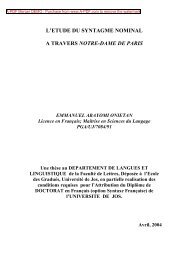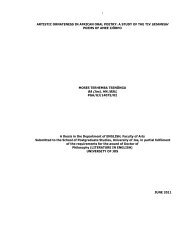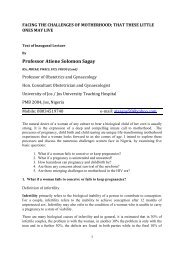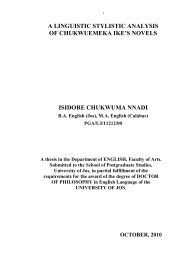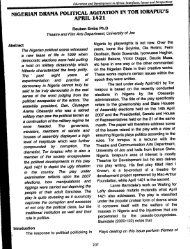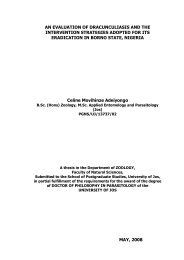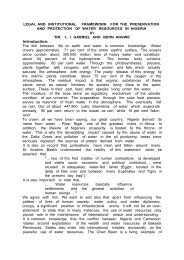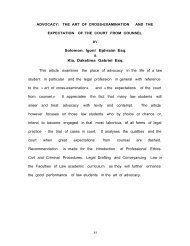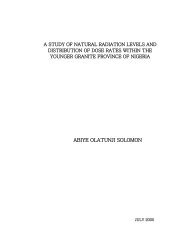Digitizing Resources in Nigeria - University of Jos Institutional ...
Digitizing Resources in Nigeria - University of Jos Institutional ...
Digitizing Resources in Nigeria - University of Jos Institutional ...
You also want an ePaper? Increase the reach of your titles
YUMPU automatically turns print PDFs into web optimized ePapers that Google loves.
Introduction<br />
<strong>Digitiz<strong>in</strong>g</strong> <strong>Resources</strong> <strong>in</strong> <strong>Nigeria</strong>: An Overview<br />
Stephen A. Ak<strong>in</strong>tunde, PhD<br />
Deputy <strong>University</strong> Librarian (Adm<strong>in</strong>. & Systems)<br />
<strong>University</strong> <strong>of</strong> <strong>Jos</strong><br />
sak<strong>in</strong>tun@gmail.com<br />
ak<strong>in</strong>s@unijos.edu.ng<br />
and<br />
Ruth Anjo<br />
Tra<strong>in</strong><strong>in</strong>g Officer/ <strong>Institutional</strong> Repository Adm<strong>in</strong>istrator<br />
<strong>University</strong> <strong>of</strong> <strong>Jos</strong> Library<br />
<strong>Jos</strong>, Plateau State<br />
anjor@unijos.edu.ng<br />
<strong>Institutional</strong> Repositories (IRs) have <strong>in</strong> the last couple <strong>of</strong> years ga<strong>in</strong>edrelevance worldwide.<br />
Repositories are <strong>of</strong>ten mentioned <strong>in</strong> connection with the Open Access movement. Among other<br />
organizations, <strong>in</strong>stitutions <strong>of</strong> higher learn<strong>in</strong>g and research <strong>in</strong>stitutes appear to be the most that are<br />
creat<strong>in</strong>g and deploy<strong>in</strong>g IRs, the availability <strong>of</strong> which is <strong>in</strong>creas<strong>in</strong>gly tied to their global visibility,<br />
especially <strong>in</strong> <strong>Nigeria</strong>. Repositories ord<strong>in</strong>arily, stock resources <strong>of</strong> an <strong>in</strong>stitution. Digital<br />
repositories store digital contents <strong>of</strong> these resources. It has also been discovered that quality<br />
researches that are self-archived <strong>in</strong> an open access platform – whether<strong>in</strong> an open access journal<br />
or archived <strong>in</strong> an <strong>in</strong>stitutional repository,have <strong>in</strong>creased citation impacts (Gargouri et al, 2010).<br />
Accord<strong>in</strong>g to eHow<strong>Institutional</strong> Repository started with the advent <strong>of</strong> the World Wide Web<br />
(WWW). In 1991 the e-pr<strong>in</strong>t service arXiv was developed by Los Alamos physicist Paul<br />
G<strong>in</strong>sparg.It eventually led to the Open Archive Initiative <strong>in</strong> which it enables <strong>in</strong>stitutional<br />
repositories to operate together.In 2001 Epr<strong>in</strong>ts was developed, while 2002 Dspace and HP and<br />
<strong>in</strong> that same year FEDORA (Flexible Extensible Digital Object Repository Architecture) was<br />
developed. These s<strong>of</strong>tware are used as platform to deploy IRs. They are the programmes that<br />
provide structured data-entry po<strong>in</strong>ts for digital resources lead<strong>in</strong>g to semantic relationships.<br />
Sematic relationships are further enhanced by the <strong>in</strong>troduction <strong>of</strong> metadata, i.e. data about data,<br />
which <strong>in</strong>creases the direct f<strong>in</strong>dability <strong>of</strong> resources, rather than mere accessibility. F<strong>in</strong>dability <strong>of</strong><br />
1
esources is used to denote the aggregation <strong>of</strong> relevant materials <strong>in</strong> their order <strong>of</strong> importance,<br />
with synonyms, and with options for different media or format, such as texts, sound, motion,<br />
graphics, or any comb<strong>in</strong>ations <strong>of</strong> these.<br />
In <strong>Nigeria</strong>, the idea <strong>of</strong> an IR is a current theme <strong>in</strong> tertiary <strong>in</strong>stitutions that have seen it as a<br />
necessity formak<strong>in</strong>g available their <strong>in</strong>stitutional resources, thereby <strong>in</strong>creas<strong>in</strong>g their visibility and<br />
better performance <strong>in</strong> the ongo<strong>in</strong>g web rank<strong>in</strong>g <strong>of</strong> world universities <strong>in</strong> particular. In the last<br />
three years, <strong>Nigeria</strong>n universities have,more or less, competed among themselves to have higher<br />
rank<strong>in</strong>g <strong>in</strong> the webometrics rank<strong>in</strong>g <strong>of</strong> world universities. This has been a healthy competition<br />
because more and more <strong>of</strong> the <strong>in</strong>stitutions have been devis<strong>in</strong>g creative means <strong>of</strong> <strong>in</strong>creas<strong>in</strong>g their<br />
digital contents <strong>in</strong> the public doma<strong>in</strong>, result<strong>in</strong>g <strong>in</strong> more <strong>Nigeria</strong>n content on the Internet, and,<br />
particularly, more openness and sharability <strong>of</strong> <strong>in</strong>stitutional resources.<br />
However,quality <strong>of</strong> the content, organizational structure <strong>of</strong> the content, management, and other<br />
such issues may need to be addressed <strong>in</strong> a policy document <strong>in</strong> order to have a virile and<br />
susta<strong>in</strong>able open access platform. Several <strong>Nigeria</strong>n <strong>in</strong>stitutions that have been post<strong>in</strong>g digital<br />
contents on the web do not appear to follow any standards and use diverse output platforms.<br />
Whereas some attempt to use open source s<strong>of</strong>tware such as Epr<strong>in</strong>ts and dspace, others simply<br />
post <strong>in</strong>to their <strong>in</strong>stitutional web content management systems that are not necessarily open<br />
source. It is imperative therefore, to look <strong>in</strong>to digitization efforts and open access movements <strong>in</strong><br />
<strong>Nigeria</strong>. This is done by briefly describ<strong>in</strong>g the path <strong>of</strong> the <strong>University</strong> <strong>of</strong> <strong>Jos</strong> <strong>in</strong> both open access<br />
<strong>in</strong>itiatives and digitization, periscop<strong>in</strong>g <strong>Nigeria</strong>, digitization as an activity, <strong>Institutional</strong><br />
Repository as an example <strong>of</strong> digitization process, challenges, and prospects, before arriv<strong>in</strong>g at a<br />
conclusion.<br />
<strong>University</strong> <strong>of</strong> <strong>Jos</strong><br />
The <strong>University</strong> <strong>of</strong> <strong>Jos</strong> library, <strong>in</strong> June 2009 became the first <strong>in</strong>stitution <strong>in</strong> <strong>Nigeria</strong> to establish an<br />
<strong>Institutional</strong> Repository (IR) (Ak<strong>in</strong>tunde, 2010), and the second <strong>in</strong> West Africa after the<br />
<strong>University</strong> <strong>of</strong> Science & Technology, Ghana. The library uses dspace, an open source self-<br />
archiv<strong>in</strong>g s<strong>of</strong>tware. This was not the university‟s first experience <strong>in</strong> the use <strong>of</strong> open source<br />
solutions. The university uses Moodle(www.unijos.edu.ng/moodle) to deliver electronic learn<strong>in</strong>g.<br />
The website <strong>of</strong> the university is managed us<strong>in</strong>g Drupal, an open source content management<br />
system. In 2003, the <strong>University</strong> <strong>of</strong> <strong>Jos</strong>, along with seven other universities <strong>in</strong> Africa, was one <strong>of</strong><br />
the found<strong>in</strong>g members <strong>of</strong> African Virtual Open Initiatives & <strong>Resources</strong> (AVOIR) which was a<br />
novel network for capacity build<strong>in</strong>g <strong>in</strong> network eng<strong>in</strong>eer<strong>in</strong>g develop<strong>in</strong>gfree and open source<br />
2
s<strong>of</strong>tware to facilitate electronic learn<strong>in</strong>g and bus<strong>in</strong>ess transactions across Africa as a first step<br />
(Keats, 2006, 2010). AVOIR developed and deployed Knowledge Environment for Web based<br />
Learn<strong>in</strong>g (KEWL) which was used to deliver the Postgraduate programme <strong>in</strong><br />
Telecommunications Policy and Regulation, sponsored by the Network <strong>of</strong> Telecommunications<br />
Policy and Regulation <strong>in</strong> Africa (NetTel@Africa), based <strong>in</strong> Tanzania.It is obvious therefore that<br />
the <strong>University</strong> <strong>of</strong> <strong>Jos</strong> was already gett<strong>in</strong>g familiar with open source s<strong>of</strong>tware when the library<br />
adopted and deployed dspace for its IR.<br />
In the Beg<strong>in</strong>n<strong>in</strong>g<br />
Digitization <strong>in</strong> the <strong>University</strong> Library actually commenced <strong>in</strong> the mid-eighties when the library<br />
hosted the <strong>Nigeria</strong>n Periodicals Index (NPI), with the then <strong>University</strong> Librarian – Late Mr. B.<br />
Nwafor serv<strong>in</strong>g as editor <strong>of</strong> NPI. The process <strong>of</strong> <strong>in</strong>dex<strong>in</strong>g required the use <strong>of</strong> computers as<br />
entries were sent <strong>in</strong> from different university libraries all over the nation, <strong>in</strong> addition to the<br />
generation <strong>of</strong> the <strong>in</strong>dex entries for the university. The Library was also fac<strong>in</strong>g the challenge <strong>of</strong><br />
manag<strong>in</strong>g the <strong>in</strong>creas<strong>in</strong>g order slips for books and journals that had piled up over years <strong>of</strong><br />
austerity started convert<strong>in</strong>g bibliographic details <strong>of</strong> books and journals purchased through the<br />
World Bank Loan facility for <strong>Nigeria</strong>n Universities. Computers were acquired to enhance the<br />
<strong>in</strong>put <strong>of</strong> orders records.<br />
So, gradually, digitization had begun and, by the late 90s, it became clear that the library could<br />
only make further advances <strong>in</strong> its efforts to digitize records <strong>of</strong> other resources even as the library<br />
automation project had gathered sufficient momentum for f<strong>in</strong>al take-<strong>of</strong>f. Hardware and<br />
<strong>in</strong>frastructural issues began to be considered more seriously. Computers with brand names such<br />
as „Compaq‟ were preferred. Electric power backup was provided for through solar panels with<br />
battery <strong>in</strong>verters. This served the computer systems <strong>in</strong> the library – at the staff work stations and<br />
<strong>in</strong> the patrons‟ area. At the turn <strong>of</strong> the new millennium, attempt was made to digitize<br />
bibliographic records <strong>of</strong> the Documents and Special Collections <strong>in</strong> the Library (Ak<strong>in</strong>tunde,<br />
2002).<br />
More advances<br />
It was perhaps this modest progress <strong>in</strong> digitization that caught the attention <strong>of</strong> the Carnegie<br />
Corporation <strong>of</strong> New York to <strong>in</strong>clude the library <strong>in</strong> its capacity build<strong>in</strong>g fund<strong>in</strong>g for the<br />
<strong>University</strong> <strong>of</strong> <strong>Jos</strong> <strong>in</strong> 2003. Thereafter, the library identified the retrospective conversion <strong>of</strong> its<br />
card catalogue as well as collection <strong>of</strong> theses and dissertations as priorities. The library was<br />
<strong>in</strong>troduced by Carnegie to the Database <strong>of</strong> African Theses and Dissertations (DATAD) based at<br />
the headquarters <strong>of</strong> the Association <strong>of</strong> African Universities <strong>in</strong> Accra, Ghanato be a contribut<strong>in</strong>g<br />
3
member. S<strong>in</strong>ce 2006, the library had been contribut<strong>in</strong>g digital copies <strong>of</strong> theses and dissertations<br />
submitted <strong>in</strong> the university to the network. It started with abstracts, but now, full texts are<br />
encouraged. With the deployment <strong>of</strong> the <strong>University</strong> <strong>of</strong> <strong>Jos</strong> <strong>Institutional</strong> Repository<br />
(http://dspace.unijos.edu.ng), full text <strong>of</strong> theses and dissertations are now uploaded <strong>in</strong> the<br />
university‟s site.<br />
The retrospective conversion <strong>of</strong> the catalogue is be<strong>in</strong>g done us<strong>in</strong>g the Bibli<strong>of</strong>ile Integrated<br />
Technical Services for W<strong>in</strong>dows (ITS). It is a proprietary s<strong>of</strong>tware which license was purchased<br />
<strong>in</strong> 2001. However, with the <strong>in</strong>tervention <strong>of</strong> the <strong>Jos</strong>-Carnegie capacity build<strong>in</strong>g project, another<br />
s<strong>of</strong>tware – Virtua was purchased as a total library solution. The same was deployed <strong>in</strong> all the six<br />
grantee <strong>Nigeria</strong>n <strong>University</strong> Libraries beneficiaries <strong>of</strong> the United States Partnership <strong>of</strong> Higher<br />
Education fund– Ahmadu Bello <strong>University</strong>, Bayero <strong>University</strong> Kano, Obafemi Awolowo<br />
<strong>University</strong>, <strong>University</strong> <strong>of</strong> Ibadan, <strong>University</strong> <strong>of</strong> <strong>Jos</strong>, and <strong>University</strong> <strong>of</strong> Port Harcourt, who were<br />
able to purchase the s<strong>of</strong>tware as a consortium. This has facilitated the creation <strong>of</strong> Onl<strong>in</strong>e Public<br />
Access Catalogue (OPAC) <strong>in</strong> these libraries. That <strong>of</strong> the <strong>University</strong> <strong>of</strong> <strong>Jos</strong> can be viewed at<br />
cactus.unijos.edu.ng:8000/cgi-b<strong>in</strong>/gw/chameleon.<br />
<strong>Nigeria</strong>n Periscope<br />
The experience <strong>of</strong> the six libraries <strong>in</strong> the digitization <strong>of</strong> their catalogue records is a common<br />
theme among <strong>Nigeria</strong>n libraries, especially university and research libraries. Most <strong>of</strong> the<br />
university libraries <strong>in</strong> the country started by apply<strong>in</strong>g The Information Navigator <strong>in</strong> Libraries<br />
(TINLIB) to commence the digitization <strong>of</strong> their catalogue card records <strong>in</strong> early 90s. The use <strong>of</strong><br />
the s<strong>of</strong>tware was not susta<strong>in</strong>able because <strong>of</strong> an apparent unreliable support as most libraries at<br />
that time, did not have the required skilled human resources as is obta<strong>in</strong>able <strong>in</strong> many libraries<br />
today; and the high cost <strong>of</strong> the license renewal, and not so perfect technical support. Moreover,<br />
there were not as many other vendors or products available <strong>in</strong> the <strong>Nigeria</strong>n market at the time.<br />
The situation has changed today. S<strong>in</strong>ce the 90s, many libraries apparently „dumped‟ TINLIB and<br />
sought for more appropriate and affordable s<strong>of</strong>tware for their <strong>in</strong>stitutions and libraries. Whereas<br />
the challenge <strong>of</strong> cost and skilled human resources have cont<strong>in</strong>ued to be def<strong>in</strong><strong>in</strong>g the acquisition<br />
and deployment <strong>of</strong> s<strong>of</strong>tware for digitization <strong>in</strong> <strong>Nigeria</strong>n libraries, most <strong>of</strong> the early attempts at<br />
digitization have been proprietary-based.<br />
However, s<strong>in</strong>ce the new millennium, and with the real challenge <strong>of</strong> fund<strong>in</strong>g <strong>in</strong> the public sector<br />
<strong>in</strong> the country, many more libraries have been research<strong>in</strong>g <strong>in</strong>to possibilities <strong>of</strong> adopt<strong>in</strong>g free and<br />
open source s<strong>of</strong>tware (FOSS) both for their catalogue records and the full texts <strong>of</strong><br />
4
documents.“Free and open source s<strong>of</strong>tware (FOSS), also known as free/libre open source<br />
s<strong>of</strong>tware (FLOSS) and free/open source s<strong>of</strong>tware (F/OSS), is s<strong>of</strong>tware developed by <strong>in</strong>formal<br />
collaborative networks <strong>of</strong> programmers. The source code is licensed free <strong>of</strong> charge, encourag<strong>in</strong>g<br />
modifications and improvements” (SearchEnterpriseL<strong>in</strong>ux, 2008).Examples <strong>of</strong> such <strong>in</strong>clude;<br />
L<strong>in</strong>ux based operat<strong>in</strong>g systems such as Ubuntu, content management systems such as Drupal,<br />
<strong>Institutional</strong> repositories such as Epr<strong>in</strong>ts, DSpace, BEPress, Fedora,OPUS, Electronic Theses and<br />
Dissertations (ETD), etc.In <strong>Nigeria</strong>, FOSS became a rally<strong>in</strong>g po<strong>in</strong>t for young and enterpris<strong>in</strong>g<br />
developers who participated at the First African Conference on the Digital Commons held at the<br />
<strong>University</strong> <strong>of</strong> Western Cape, January 2004 (Keats, 2004). They returned to the country and<br />
created a network <strong>of</strong> FOSS advocates us<strong>in</strong>g the platform: www.ngfossf.org. Idlelo, coupled with<br />
<strong>in</strong>teractions at the biennial Committee on Development Information (CODI) <strong>in</strong> Addis Ababa,<br />
Ethiopia, was a common ground to share experiences with other developers <strong>in</strong> Africa,<br />
particularly Kenyan and South African friends. But most <strong>of</strong> the FOSS <strong>in</strong>itiatives focused on<br />
bus<strong>in</strong>ess and organizational solutions, not necessarily library.<br />
The ma<strong>in</strong> constra<strong>in</strong>t <strong>in</strong> adopt<strong>in</strong>g FOSS, by <strong>Nigeria</strong>n libraries has beenthe availability <strong>of</strong> technical<br />
support <strong>in</strong> respective libraries. Some <strong>of</strong> the s<strong>of</strong>tware used <strong>in</strong>clude UNESCO‟sCDS/ISIS,<br />
Greenstoneand Koha. Koha is used by a few academic <strong>in</strong>stitutions <strong>in</strong>clud<strong>in</strong>g Bowen <strong>University</strong>,<br />
Iwo and Osun State <strong>University</strong>, Osogbo. Other universities use varied s<strong>of</strong>tware – from open to<br />
proprietary.A full census <strong>of</strong> these s<strong>of</strong>tware will need to be done <strong>in</strong> order to be able to harness<br />
resources and provide synergy <strong>in</strong> the libraries. So much tra<strong>in</strong><strong>in</strong>g was carried out by UNESCO<br />
for CDS/ISIS <strong>in</strong> late 90s and for Greenstone <strong>in</strong> the first few years <strong>of</strong> the new millennium.<br />
The <strong>Nigeria</strong>n Information Technology Development Agency (NITDA) attempted to lead <strong>in</strong> the<br />
implementation <strong>of</strong> Greenstone <strong>in</strong> particular. However, look<strong>in</strong>g back, it is not clear how much<br />
success it has had <strong>in</strong> this. More importantly, it is still not clear whether respective stakeholders <strong>in</strong><br />
<strong>Nigeria</strong> – librarians, s<strong>of</strong>tware vendors, Government agencies, and developers know that the<br />
essence <strong>of</strong> <strong>in</strong>troduc<strong>in</strong>g and adopt<strong>in</strong>g any s<strong>of</strong>tware is for the purpose <strong>of</strong> digitiz<strong>in</strong>g resources. If<br />
there had been a clear objective, there would, probably by now have been a greater<br />
accomplishment <strong>in</strong> the digitization project <strong>in</strong> <strong>Nigeria</strong>.This would have significantly <strong>in</strong>creased<br />
<strong>Nigeria</strong>n „local‟ content on the World Wide Web.<br />
However, there are quite a handful <strong>of</strong> libraries that have tried out Greenstone. They <strong>in</strong>clude the<br />
National Library <strong>of</strong> <strong>Nigeria</strong> – <strong>in</strong> the digitization <strong>of</strong> newspapers, Federal M<strong>in</strong>istry <strong>of</strong> Health,<br />
Ladoke Ak<strong>in</strong>tola <strong>University</strong> Ogbomoso, Federal Polytechnic Ado-Ekiti, <strong>Nigeria</strong>n Educational<br />
Research Development Council (NERDC), and Media Trust (publishers <strong>of</strong> „Daily Trust‟<br />
5
newspaper). The National Centre for Digitization, affiliated with African Digital Library Support<br />
Network (ADLSN) has now tak<strong>in</strong>g up the challenge <strong>of</strong> ensur<strong>in</strong>g that there is sufficient advocacy<br />
and understand<strong>in</strong>g <strong>of</strong> the possibilities <strong>of</strong> Greenstone and to provide technical support too. The<br />
end objective is to ensure systematic digitization <strong>of</strong> local resources <strong>in</strong> <strong>Nigeria</strong>.<br />
As mentioned earlier, the <strong>University</strong> <strong>of</strong> <strong>Jos</strong> library <strong>in</strong> May 2009, adopted Dspace for her<br />
<strong>Institutional</strong> repository. Dspace is a Free and Open Source S<strong>of</strong>tware that was developed by MIT<br />
(Massachusetts Institute <strong>of</strong> Technology) and HP (Hewlett-Packard) <strong>in</strong> 2002.One <strong>of</strong> the major<br />
advantages <strong>of</strong> DSpace is its flexibility and ease <strong>of</strong> usage. Repositories <strong>of</strong> three other universities<br />
have been captured by the Directory <strong>of</strong> Open Access Repositories (DOAR) (2012). They are:<br />
Covenant <strong>University</strong> – Epr<strong>in</strong>ts, Federal <strong>University</strong> <strong>of</strong> Technology Akure – DSpace, and<br />
<strong>University</strong> <strong>of</strong> <strong>Nigeria</strong> Nsukka – (unidentified). The four repositories were registered with DOAR<br />
on the follow<strong>in</strong>g dates: <strong>University</strong> <strong>of</strong> <strong>Jos</strong> – June 2009, <strong>University</strong> <strong>of</strong> <strong>Nigeria</strong> – 2010(?), Covenant<br />
<strong>University</strong> – December 2010, Federal <strong>University</strong> <strong>of</strong> Technology Akure, 2011.<br />
Digitization<br />
Accord<strong>in</strong>g to Wikipedia (2012),“digitiz<strong>in</strong>g or digitization is the representation <strong>of</strong> an object,<br />
image, sound, document or a signal (usually an analog signal) by a discrete set <strong>of</strong> its po<strong>in</strong>ts or<br />
samples.The result is called digitalrepresentation or, more specifically, a digital image, for the<br />
object, and digital form, for the signal”.This means the transformation <strong>of</strong> an object from analog<br />
to digital. In simple language it means the conversion <strong>of</strong> hard texts <strong>in</strong>to s<strong>of</strong>t copies that can be<br />
manipulated. This may <strong>in</strong>volve text, sound, image, or voice which are converted <strong>in</strong>to a s<strong>in</strong>gle<br />
b<strong>in</strong>ary code (VanDeCarr, n.d.).<br />
In <strong>Nigeria</strong>, digitization is currently on the table and will be for some time to come until perhaps<br />
another technology overtakes it.However, the rate at which <strong>in</strong>stitutions and organizations see this<br />
as a priority will depend upon the exposure <strong>of</strong> <strong>in</strong>stitutional heads and the urgency that librarians<br />
and other stakeholders see it, even <strong>in</strong> the midst <strong>of</strong> <strong>in</strong>frastructural challenges.<br />
Digitizationholds the advantage <strong>of</strong> provid<strong>in</strong>g a platform for sharability and duplicity <strong>of</strong> data, and<br />
network<strong>in</strong>g because <strong>of</strong> the digital form <strong>of</strong> content. It also enhances the life-span <strong>of</strong> records as<br />
well as secur<strong>in</strong>g data and records that would have been obliterated due to their age. Digital<br />
content can easily be sieved, isolated, and used without distort<strong>in</strong>g the data structure. So, the old<br />
practice <strong>of</strong> librarians <strong>in</strong> „selective dissem<strong>in</strong>ation <strong>of</strong> <strong>in</strong>formation‟ can be done more conveniently<br />
<strong>in</strong> a digital environment by merely touch<strong>in</strong>g computer keys and icons, because automatic<br />
<strong>in</strong>dex<strong>in</strong>g and semantic relationships are carried out <strong>in</strong> the design <strong>of</strong> different s<strong>of</strong>tware for<br />
6
manag<strong>in</strong>g digitized content. Every effort should therefore be made to digitize and promote<br />
digitization, particularly <strong>in</strong> libraries where <strong>in</strong>formation is essentially harnessed for shar<strong>in</strong>g to<br />
communities <strong>of</strong> users, with different <strong>in</strong>formation needs.<br />
<strong>Institutional</strong> Repository: an example <strong>of</strong> a Digitization process<br />
Digitization, no doubt, is a process. It is the process <strong>of</strong> preserv<strong>in</strong>g, liberaliz<strong>in</strong>g and<br />
<strong>in</strong>ternationaliz<strong>in</strong>g access to documents with the ultimate aim <strong>of</strong> improv<strong>in</strong>g their usability by<br />
convert<strong>in</strong>g them <strong>in</strong>to digital form. From the <strong>University</strong> <strong>of</strong> <strong>Jos</strong> experience, there are several issues<br />
to consider, several stages to go through. Key considerations <strong>in</strong>clude when to embark on<br />
digitization, what to digitize, selection issues, how to go about it, who can be <strong>in</strong>volved, where to<br />
do the digitization, copyright issues, the target audience, and s<strong>of</strong>tware.<br />
When do we digitize?<br />
There needs to be a consideration <strong>of</strong> the level <strong>of</strong> collection to digitize, an understand<strong>in</strong>g <strong>of</strong> the<br />
physical state <strong>of</strong> library collections, and the status <strong>of</strong> materials – are they commonly available or<br />
rare materials? Obviously, rare materials should receive prior attention. The question <strong>of</strong><br />
availability <strong>of</strong> staff to carry out digitization is also there: Does the library have sufficiently<br />
skilled staff to carry out digitization and content management? Is the library ready to become<br />
more globally visible? And, will digitization enhance the use <strong>of</strong> library resources?<br />
What to digitize<br />
There needs to be criteria for the selection <strong>of</strong> what to digitize. Is there a Collection Development<br />
Policy? Is there a Digitization Policy – either <strong>in</strong> the Library or the organization? What format <strong>of</strong><br />
materials are to be digitized – only texts, audio, video, etc.? Would it be vulnerable materials or<br />
just any material?<br />
Selection issues<br />
Key considerations <strong>in</strong> the selection <strong>of</strong> materials to digitize <strong>in</strong>clude the <strong>in</strong>tellectual value <strong>of</strong> the<br />
collections, number and location <strong>of</strong> exist<strong>in</strong>g and potential users <strong>of</strong> library collections, pattern <strong>of</strong><br />
use <strong>of</strong> library materials, <strong>in</strong>tellectual property issues, and cost (The <strong>University</strong> <strong>of</strong> Southern<br />
Mississippi Libraries Digital Program (2009).<br />
How do we go about digitiz<strong>in</strong>g?<br />
Considerations here <strong>in</strong>clude what method to adopt? What type <strong>of</strong> equipment? Will it be a special<br />
project or it will be considered as a rout<strong>in</strong>e work <strong>in</strong> the library? Would digitization be done <strong>in</strong>-<br />
house or out-sourced? All these questions need to be answered concretely before embark<strong>in</strong>g on<br />
digitization. The approach to digitization may best be determ<strong>in</strong>ed by the library or <strong>in</strong>stitutional<br />
7
management who may also decide on the format <strong>of</strong> material to be digitized and the available<br />
fund<strong>in</strong>g.<br />
Where to carry out digitization<br />
This has to do with whether it is <strong>in</strong>-house or as a special project. They all have implications for<br />
the outcome <strong>of</strong> the project.Where a decision is taken to make digitization a „project‟, there must<br />
necessarily be a Project Management Team who are given a specific task, <strong>in</strong> a specific time-<br />
frame, designated staff for the project, special budgetary allocation, and must be result –<br />
oriented. Where a library or organization decides to classify digitization as a „normal‟ rout<strong>in</strong>e<br />
duty, for whatever reasons, it is possible that digitization may not necessarily be time-bound, it<br />
may and may not have designated staff, may not have special budgetary allocation, and the result<br />
may be tied to bureaucracy and the disposition <strong>of</strong> staff <strong>in</strong> charge or the head <strong>of</strong> library or<br />
<strong>in</strong>stitution.<br />
Copyright issues<br />
This is critical because all <strong>in</strong>tellectual property materials must be duly acknowledged at every<br />
stage <strong>of</strong> use, and permissions secured. Violation <strong>of</strong> <strong>in</strong>tellectual property rights must be avoided at<br />
every <strong>in</strong>stance. So, where possible, permission must be secured before conversion <strong>of</strong> any item is<br />
done from analogue to digital.<br />
Target audience<br />
The target audience should equally be determ<strong>in</strong>ed because this may <strong>in</strong>struct the structure,<br />
organization, and quality <strong>of</strong> content. The design <strong>of</strong> the <strong>in</strong>terface between the library staff and<br />
users will need to reflect the type <strong>of</strong> audience <strong>in</strong> view – local, national, or <strong>in</strong>ternational. It is<br />
advisable that <strong>in</strong>ternational standards be observed when embark<strong>in</strong>g on digitization.<br />
S<strong>of</strong>tware<br />
The decision on the s<strong>of</strong>tware to use can be done when issues raised above have been resolved<br />
and decisions taken. The s<strong>of</strong>tware may not be the first consideration. The s<strong>of</strong>tware chosen must<br />
be supported by appropriate hardware and peripherals, and necessary <strong>in</strong>frastructure such as<br />
electric power back-up, and network facilities.<br />
The digitization process also <strong>in</strong>cludes:<br />
i. S<strong>of</strong>tware <strong>in</strong>stallation:There are a number <strong>of</strong> repository s<strong>of</strong>twares available. They are<br />
Fedora, Epr<strong>in</strong>ts, Dspace etc. these s<strong>of</strong>tware are mostly free and open source<br />
s<strong>of</strong>twares. They can be <strong>in</strong>stalled on any server and operat<strong>in</strong>g system. They are easy to<br />
use and are customizable.<br />
8
ii. Prioritiz<strong>in</strong>g <strong>of</strong> materials to be digitized:This may be for reasons <strong>of</strong> visibility,<br />
accessibility, or state <strong>of</strong> the material.<br />
iii. Sensitizations:the library community needs sensitization on what the library is about<br />
embark<strong>in</strong>g upon, what digitization <strong>in</strong>volves and implies for them, and should be<br />
<strong>in</strong>vited to the launch <strong>of</strong> the digitization „project‟. The sensitization should not be<br />
limited to the patron community. Even library staff had to be sensitized before we<br />
launched out <strong>in</strong> order for them to be duly knowledgeable about library <strong>in</strong>itiatives.<br />
iv. Self – archiv<strong>in</strong>g: An <strong>Institutional</strong> repository is an onl<strong>in</strong>e database that encourages<br />
self – archiv<strong>in</strong>g. Self-archiv<strong>in</strong>g is a process whereby creators <strong>of</strong> records or authors <strong>of</strong><br />
documents are able to upload their works <strong>in</strong>to the repository by themselves, and make<br />
their work available free <strong>in</strong> the public doma<strong>in</strong>.<br />
v. Upload<strong>in</strong>g:Born digital copies <strong>of</strong> materials are preferred for digitiz<strong>in</strong>g because all<br />
that is needed is formatt<strong>in</strong>g and tagg<strong>in</strong>g <strong>of</strong> metadata. For contents that are not <strong>in</strong> s<strong>of</strong>t<br />
copies scanners are available to convert then to s<strong>of</strong>t copies so that they can be<br />
uploaded. File formats that can be uploaded are pdf, doc, ppt, cdr, jpg etc.<br />
vi. Review:An adm<strong>in</strong>istrator is needed to review each upload or submission metadata,<br />
otherwise, when queries are made, errors may accumulate.<br />
vii. Policy: It iscritical to develop a digitization policy. However, this should not slow<br />
Challenges<br />
down the process, as policy can also be developed and reviewed and updated from<br />
time to time. The policy, preferably written policy, sets the boundary <strong>of</strong> operation, <strong>in</strong><br />
terms <strong>of</strong> content, priorities, and <strong>in</strong>tellectual property rights.<br />
Some <strong>of</strong> the identifiable challenges to digitization <strong>in</strong> <strong>Nigeria</strong> are:<br />
a. Human resources:skilled human resources are needed to carry out digitization – to<br />
identify resources, submit, <strong>in</strong>to the workflow, and adm<strong>in</strong>ister. Teachable staff <strong>of</strong> any<br />
library or <strong>in</strong>stitution can be tra<strong>in</strong>ed to do this. However, it is imperative to have at least<br />
one technical staff – preferably a computer scientist, who can easily trouble shoot and fix<br />
bugs. These staff should be library staff. For now, many libraries do not seem to have this<br />
staff pr<strong>of</strong>ile. In the <strong>University</strong> <strong>of</strong> <strong>Jos</strong>, the Systems Unit has six Computer Science<br />
graduates who are work<strong>in</strong>g on the various digitization fronts <strong>of</strong> the library. One <strong>of</strong> them<br />
adm<strong>in</strong>isters the <strong>Institutional</strong> Repository.<br />
9
. Support from the community:In terms <strong>of</strong> usage and upload<strong>in</strong>g <strong>of</strong> content, the<br />
responsefrom the academic community so farhas yet to meet with our expectations, even<br />
after several rounds <strong>of</strong> sensitization. However, it is evident that more responses have<br />
been received after each sensitization programme. So, the library will have to keep go<strong>in</strong>g<br />
after the user community and content providers.<br />
c. Lack <strong>of</strong> adequate power:The electricity power sector <strong>Nigeria</strong>n is poor and it really<br />
Prospects<br />
affects the servers that house the repository. Power back – ups, as they are, are not a<br />
permanent solution; they are a temporary solution for power exchange. We have had to<br />
experiment with three sources <strong>of</strong> power supply – a 60KVA generator for the library, a<br />
100KVA generator for the <strong>University</strong>‟s Datacenter, and the Power Hold<strong>in</strong>g Company <strong>of</strong><br />
<strong>Nigeria</strong>. In the past, we had solar panels with <strong>in</strong>verters as back-ups, but the batteries ran<br />
down because the wrong life-span was supplied. Librarians will have to determ<strong>in</strong>e the<br />
type and life-span <strong>of</strong> batteries before <strong>in</strong>vest<strong>in</strong>g <strong>in</strong> them.<br />
Digitization holds great promise for preservation <strong>of</strong> materials, sharability <strong>of</strong> resources, and<br />
visibility <strong>of</strong> <strong>Nigeria</strong>n libraries and <strong>in</strong>stitutions. The <strong>in</strong>crease <strong>in</strong> <strong>Nigeria</strong>n content on the Web will<br />
enable more mean<strong>in</strong>gful and fruitful researches to be conducted through access to relevant data<br />
and literature. <strong>Nigeria</strong>n libraries will also be able to communicate more pr<strong>of</strong>essionally with<br />
colleagues <strong>in</strong> other parts <strong>of</strong> the globe. The choice and deployment <strong>of</strong> appropriate s<strong>of</strong>tware will<br />
particularly br<strong>in</strong>g contents together and provide a common platform for the exchange <strong>of</strong><br />
knowledge <strong>in</strong> today‟s knowledge society.<br />
Accord<strong>in</strong>g to Bashiru (2010), today, “the global village is be<strong>in</strong>g described on thebasis <strong>of</strong> ICT as<br />
<strong>in</strong>formation rich northern hemisphere and <strong>in</strong>formation poor southern hemisphere <strong>of</strong> which<br />
<strong>Nigeria</strong> is one. A major characteristic <strong>of</strong> an <strong>in</strong>formation poor society isLow-level ICT with<br />
m<strong>in</strong>imum local content on the web for local and global consumption”.<strong>Nigeria</strong> can only be part <strong>of</strong><br />
this global movement by us<strong>in</strong>g ICT to bridge the gap and cross over.<br />
Conclusion<br />
Digitization and open access <strong>in</strong>itiatives go hand-<strong>in</strong>-hand. <strong>Institutional</strong> repositories can br<strong>in</strong>g<br />
about the transformation that is needed <strong>in</strong> the delivery <strong>of</strong> library services today. The use <strong>of</strong> free<br />
and open source s<strong>of</strong>tware requires technical support which <strong>Nigeria</strong>n librarians and developers<br />
10
must rise up to. It is imperative that if <strong>Nigeria</strong>n libraries must overcome the perennial budget<br />
costs, then, digitization must be seen as a „smart‟ solution that br<strong>in</strong>gs about the possibilities <strong>of</strong><br />
shar<strong>in</strong>g resources with other <strong>in</strong>stitutions that are richer and will easily put their resources <strong>in</strong> the<br />
public doma<strong>in</strong>.But we have to first digitize our content and share the resources. This is the<br />
paradigm shift. It is a challenge <strong>of</strong> openness and visibility. It is a possibility. We have started.<br />
We cannot afford to look back. We have crossed the Rubicon, and cannot turn back.<br />
11
References<br />
Ak<strong>in</strong>tunde, Stephen A. (2010). “Blaz<strong>in</strong>g the trail: <strong>Institutional</strong> Repository at the <strong>University</strong> <strong>of</strong><br />
<strong>Jos</strong>”, <strong>Nigeria</strong>n Libraries: Journal <strong>of</strong> the <strong>Nigeria</strong>n Library Association, 43:1-19.<br />
Ak<strong>in</strong>tunde, Stephen A. (2002). “Say IT Aga<strong>in</strong>: We Just Took Off!” <strong>Nigeria</strong>n Libraries:<br />
Journal <strong>of</strong> the <strong>Nigeria</strong>n Library Association, 36(2): 1-14.<br />
Ak<strong>in</strong>tunde, S. A. & Ojoade, A. B.(1995). "Com<strong>in</strong>g <strong>of</strong> Age: Automation <strong>in</strong> the<br />
<strong>University</strong> <strong>of</strong> <strong>Jos</strong> Library". 28p. http://dspace.unijos.edu.ng/handle/10485/857<br />
Bashiru A. S. (2010) Issues and Challenges <strong>in</strong> the Creation <strong>of</strong> <strong>Institutional</strong> Repositories with<br />
Local Content: Critical Reflections.Information, Society and Justice, (3)1: 59-68.<br />
Directory <strong>of</strong> Open Access Repositories ((2012). http://www.opendoar.org/f<strong>in</strong>d.php<br />
AccessedApril 23, 2012.<br />
Flew, T. (2008). New Media An Introduction. South Melbourne. 3rd Edition. South Melbourne:<br />
Oxford <strong>University</strong> Press.<br />
Gargouri, Y; Hajjem, C.; Larivière, V.; G<strong>in</strong>gras, Y; Carr, L.; Brody, T;& Harnad, S. (2010) Open<br />
Access, Whether Self-Selected or Mandated, Increases Citation Impact, Especially for<br />
HigherQuality Research. http://openaccess.epr<strong>in</strong>ts.org/<strong>in</strong>dex.php?/archives/168-The-Self-Archiv<strong>in</strong>g-<br />
Impact-Advantage-Quality-Advantage-or-Quality-Bias.html Retrieved August 03, 2010<br />
Keats, D. (2004). Idlelo: First African Conference on the Digital Commons F<strong>in</strong>al Report to<br />
Department <strong>of</strong> Science & Technology South Africa, submitted by Derek Keats.<br />
http://idlelo.net/sites/default/files/Idlelo1%20Report.pdf Accessed April 23, 2012.<br />
Keats, D. (2006). African Virtual Open Initiatives and <strong>Resources</strong> (AVOIR): a network for<br />
capacity build<strong>in</strong>g <strong>in</strong> s<strong>of</strong>tware eng<strong>in</strong>eer<strong>in</strong>g <strong>in</strong> Africa. United Nations Workshop for African<br />
Parliamentary <strong>in</strong>formation systems.<br />
http://www.parliaments.<strong>in</strong>fo/downloads/14%20Derek%20Keats%20-<br />
%20African%20Virtual%20Open%20Initiatives%20and%20<strong>Resources</strong>%20%28AVOIR%29%2<br />
0a%20network%20for%20capacity%20build<strong>in</strong>g%20<strong>in</strong>%20s<strong>of</strong>tware%20eng<strong>in</strong>eer<strong>in</strong>g%20<strong>in</strong>%20A<br />
frica.pdf Accessed April 23, 2012.<br />
12
Keats, D. (2010). The SA Grid Comput<strong>in</strong>g Initiative: it‟s all about collaboration and synergy.<br />
http://kim.wits.ac.za/<strong>in</strong>dex.php?module=blog&postid=gen11Srv0Nme53_54819_1269710695&a<br />
ction=views<strong>in</strong>gle&userid=5080090128 Accessed April 23, 2012.<br />
Knowledge Environment for Web-based Learn<strong>in</strong>g (2009). http://sourceforge.net/projects/kewl/<br />
Accessed April 23, 2012.<br />
Okerson, A. S. & O'Donnell, J. J. eds. (1995). Scholarly Journals at the Crossroads: A<br />
Subversive Proposal for Electronic Publish<strong>in</strong>g. Association <strong>of</strong> Research Libraries. Retrieved<br />
from http://www.arl.org/sc/subversive/<br />
SearchEnterpriseL<strong>in</strong>ux (2008). Free and open source s<strong>of</strong>tware (FOSS) or free/libre open source<br />
s<strong>of</strong>tware (FLOSS). http://searchenterprisel<strong>in</strong>ux.techtarget.com/def<strong>in</strong>ition/Free-and-open-source-<br />
s<strong>of</strong>tware-FOSSAccessed April 23, 2012.<br />
<strong>University</strong> <strong>of</strong> Southern Mississippi Libraries (2003). Guidel<strong>in</strong>es for<br />
digitization.http://www.lib.usm.edu/legacy/spcol/crda/guidel<strong>in</strong>es/<strong>in</strong>dex.htmlAccessed October 9,<br />
2009.<br />
VanDeCarr D. (n.d.)The <strong>Digitiz<strong>in</strong>g</strong> Process: How it<br />
works.http://www.edb.utexas.edu/m<strong>in</strong>liu/multimedia/PDFfolder/<strong>Digitiz<strong>in</strong>g</strong>Process.pdf Accessed<br />
April 24, 2012.<br />
Wikipedia: The Free Encyclopedia (2012). <strong>Digitiz<strong>in</strong>g</strong>. http://en.wikipedia.org/wiki/<strong>Digitiz<strong>in</strong>g</strong><br />
Accessed April 24, 2012.<br />
13




